Site menu:
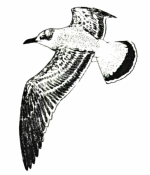
April 2015 Newsletter
Species Spotlight - Cormorant.
Colour Ring Report.
Hilbre Video.
March Bird News.
Forthcoming Events.
Latest Newsletter.
Species Spotlight - Cormorant
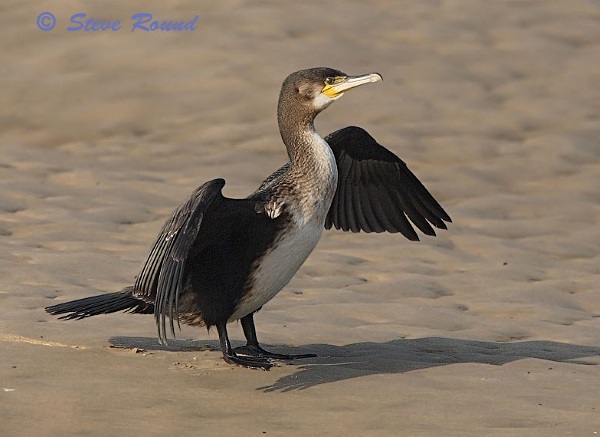
At dawn on Jan 20th 2015 3,884 Cormorants flew
out of the Dee estuary past Hilbre Island. This is 11.1% of the
over-wintering population for the whole of this country, a remarkable
number and undoubtedly the highest ever single count in the UK for this
species.
Numbers had been building up all winter, nearly all the high counts
were of birds flying out of the estuary at dawn, these
included: 1,483 on Nov 9th, 1,518 on Dec 16th, 1,794 on Dec 30th, 2,270
on Jan 14th and 3,336 on Jan 19th. On Jan 7th 1,900 were counted at
dusk flying into the estuary and the following morning 1,940 were duly
counted flying out again - presumably this meant that the birds were
forming a large night roost somewhere in the estuary, but where? The
question was answered by Colin Wells, RSPB Site Manager for the Dee
Estuary, following discussions with the Hilbre Bird Observatory
Secretary (Steve Williams), and I quote from the HiBO blog:
"I was interested to
read HiBO’s reports of large numbers of Cormorants leaving the estuary
at dawn, this ties in with recent counts I have carried out from
Parkgate and the discovery of the night time roost site on the edge of
the saltmarsh at Burton (Dee Estuary RSPB Reserve). Over the last
couple of years whilst carrying out the Hen Harrier roost survey at
Parkgate I have observed flocks of Cormorants flying up stream at dusk,
about 2 km out following the edge of the outer saltmarsh and often
wondered where they were roosting. Day time high tide WeBS counts have
shown that Cormorants are increasing in the North West and
internationally important numbers occur on the estuary.
On 16th December 2014,
Dan Trotman and I were carrying out the WeBS low water count off Burton
Marsh when we came across a large area of white washed pioneer
saltmarsh which smelt very strongly of what I can only describe as a
fish market on a hot day! Tell tale signs of black feathers suggested
that this is the site of a massive Cormorant roost. One late afternoon
I located a vantage point along Well Lane, Ness and I was able to see a
huge black mass of Cormorants in the fading light at the roost location.
Since then I have
carried out counts from Parkgate, birds noted to fly upstream about two
hours before dusk, counts as follows: 1,100 on 29th Dec, 1,400 on 2nd
Jan, 1,700 on 10th Jan and 2,000 on 18th Jan. It is possible that a lot
of birds are missed due to the distance involved and poor light
conditions, I have noted that birds are still coming in when it is
virtually dark. These circumstances could account for the discrepancy
between my counts & HiBO’s.
As far as I’m aware the
Hilbre count of 3,884 is an all time record for the UK, the previous
record being from the Ribble.
One would presume that
these birds are the same as the one’s I’ve counted from Parkgate and
are roosting at Burton. From my research, it appears that the Dee
Estuary has one of the largest night time roosts of cormorants in the
UK. The big question is "where are they feeding and how far are they
travelling to the roost from within Liverpool Bay?” So
hopefully I have answered your question where they are roosting!" Colin
Wells.
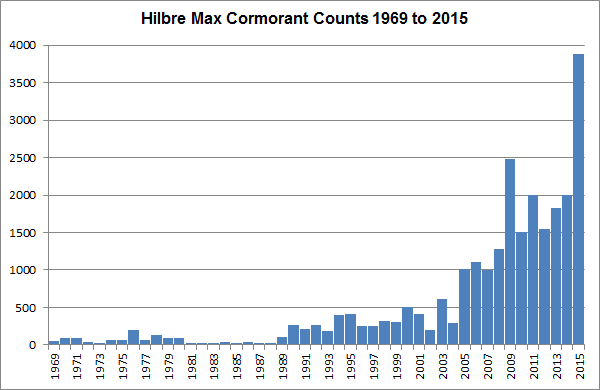
Just how steeply numbers have increased
at Hilbre is shown by Figure 1. After very low numbers in the 1980s,
for example 1987 max was just 33 (in June), there was a step
change upwards
in the 1990s followed by a steep increase from 2000 onwards.
Figure
2 shows the Dee estuary WeBS (Wetland Bird Survey) counts also
increasing
significantly and there was a record WeBS count for the
estuary of 1,633 on
Nov 18th 2013.
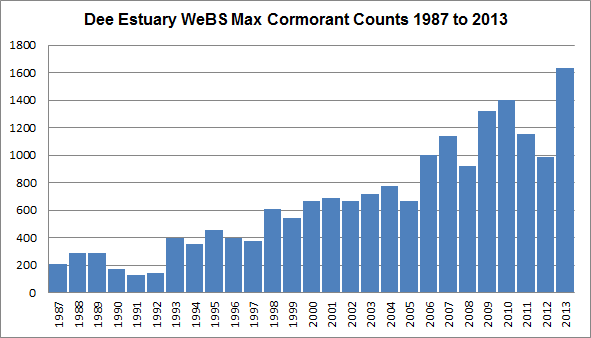
There have been similar increases in
the nearby
Ribble
estuary, with a max of 543 in 2005 increasing to 3,297 by December 2012
and a 2013 max of 2,586 in December. All this means is that Liverpool
Bay is currently the most important over-wintering area in the UK for
this
species.

The Great Cormorant Phalacrocorax carbo (to use it's full and scientific names) increased substantially across the whole of Western Europe in the latter part of the 20th century, fuelled at least partly by reduced persecution thanks to the EU's Bird Directive enacted in 1979. However, in the 21st century numbers have levelled off or even decreased. In the UK the Index for breeding birds increased from a baseline of 100 in 1986 to a peak of 150 in 1995 after which there has been an overall decline down to 90 in 2013. WeBS winter counts for the whole of the UK increased from an index of 56 in 1987/88 to a max of 117 in 2003/04 then down to 100 in 2012/13. This is in marked contrast to the sharp increase in the Dee and Ribble Estuaries over the past 10 years.
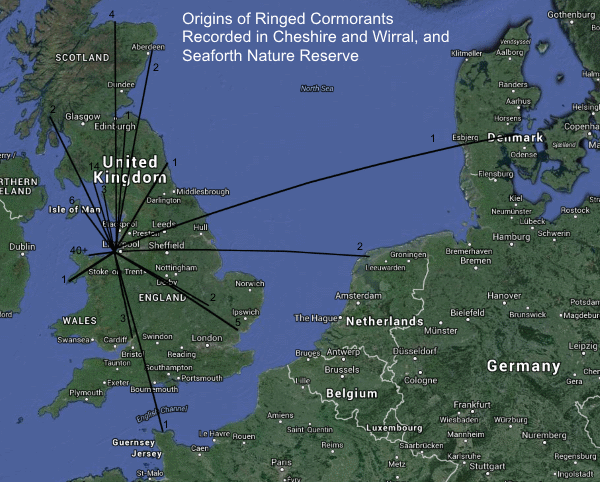
The map shows a good proportion of the ringed birds recorded over the past 15 years or so in Cheshire, Wirral and Seaforth Nature Reserve. Seaforth, just across the River Mersey from New Brighton, is much used by Cormorants for roosting, particularly during storms, and is a very good site for spotting colour rings. The large majority of Cormorants are ringed as chicks on the nest so the map tells us where our over-wintering birds breed. As you might expect most breed along the coasts of the Irish Sea and nearby adjacent areas such as the Severn Estuary and Loch Fyne, and that comes to 78% of the total.
But it's the other 22% which is intriguing. Birds breeding in the Netherlands and Denmark are all of the sinensis race, whereas it is generally thought all the birds in the Irish Sea are of the coastal breeding carbo race - but our map indicates that that may not be wholly true with sinensis flying across the North Sea and over the UK. In the UK the majority of inland breeding birds are also sinensis so again it's interesting that five birds from Abberton Reservoir and two from Grafham/Rutland Water have also ended up in Liverpool Bay, but here things aren't quite as clear as not only do some carbo breed inland there is also evidence for hybridisation between the races - nevertheless a north-west movement is unexpected. One of the birds ringed at Grafham Water was satellite tagged and was tracked not only to Seaforth but also off north Wirral and in the Dee estuary itself. Whatever the race of these birds the fact they are flying such a long distance to Liverpool Bay shows it's importance as a winter feeding area.
Both the Hilbre and Dee Estuary WeBS monthly counts show it is only over the past eight years that large numbers have appeared mid-winter, whereas previously the peak has always been in September - Hilbre data is shown in Figs 3 and 4.

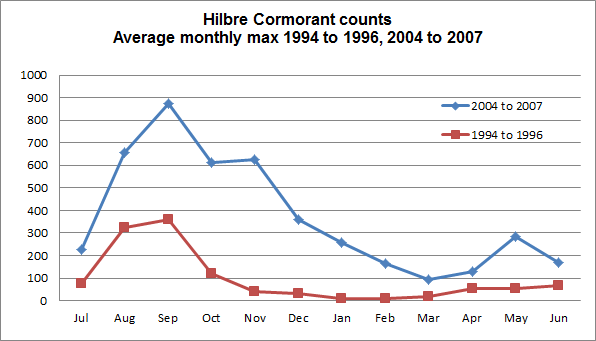
So it seems that during the rapid rise
in numbers in Liverpool Bay over the past few years there has been a
particularly dramatic increase in over-wintering birds and as this has
occurred during a time when national numbers have been decreasing they
must have re-located from elsewhere. The ringing returns indicate that
it is certainly possible that some of these Cormorants are sinensis, may be
from both the continent and inland in the UK. Of note is that
Cormorants only started breeding successfully in Cheshire in
2004 since when numbers have increased significantly so that in 2013
there were at least 184 pairs, equating to 736 birds if we assume two
young successfully fledged - a very significant increase from zero in
2003! We don't really know what race these birds are but expert opinion
is that they are mostly sinensis.
So do these local nesting birds disperse inland in winter or are do
they fly just a short distant to the Dee Estuary and Liverpool Bay? We
don't know but it does
seem a hell of a coincidence to have two adjacent
populations increasing rapidly at the same time.
Another source for our birds could be due to the relocation of
carbo birds
from within the Irish Sea and adjacent areas and, looking at WeBS data,
it is noticeable that there has been a sharp fall in numbers in
Northern Ireland since 2005, from around 2,684 in 2005/06 to to 1,535
in 20012/13, if they have all moved to Liverpool Bay than these would
account for a good proportion of the increase.
So far in this article I have refrained from using the four letter 'F' word - that is to say Fish! Because Cormorants eat fish they have come into conflict with man over many centuries, but particularly during the 19th century and the first half of the 20th. European legislation in the 20th century resulted in a big increase in numbers as previously stated, but this has now brought them into further conflict with the fishery industry and culling is now once again taking place, albeit in a controlled manner. Whether this culling is really necessary is disputed.
On the subject of culling and persecution I finish with some quotes and if anybody has any problems with what they say please take it up with the authors, and not me!
David Norman (Ref 13): The Cormorants' move to breeding and wintering inland in the UK is an apt metaphor for man's abuse of the environment. Man has ovefished the seas and overstocked some inland waters; it is not surprising that this adaptable seabird has responded.
S. Van Rijn (Ref 14): No significant conflicts with
commercial fisheries occur at present in the Netherlands. Most
commercial fisheries are aware that Great Cormorants are not the main
problem concerning the general decline of the commercial fish catch.
The fact that the Netherlands have no active management or regulation
of breeding numbers is unique in Europe. This shows that communication
about the ecological position of Great Cormorants and other fish-eating
birds can result in a better understanding of a changing world.
.....the extent to which cormorants actualy harm human interests is unclear. Some prey species are commercially valuable but the bulk of the cormorant's diet consists of species not valued by humans. And despite it's reputation for devouring fish, its daily food consumption relative to body mass is no greater than that for other fish-eating birds. To date no study has demonstrated that cormorants pose a threat to the survival of healthy fish populations in natural systems.
Ultimately, the cormorant's story reflects a culture still deeply prejudiced against creatures that exist outside the boundaries of human understanding and acceptance. To determine wildlife policy for these and other such creatures in the absence of scientific evidence is deeply flawed.
References/Sources of Information:
1. Hilbre Bird Observatory database, with thanks to Steve Williams. See Hilbre Bird Observatory Blog.
2. Colin Wells, RSPB Dee Estuary Manager.
3. Colin Wells and Neil Friswell, Dee Estuary and North Wirral Forseshore WeBS Annual Report 2012/13.
4. BTO WeBS Report: Waterbirds in the UK 2012/13 (and online historical data).
5. Cheshire and Wirral Bird Reports - 1987 to 2013, CAWOS.
6. Lancashire Bird Reports - 1995 to 2013.
7. Bird Atlas 2007-11, BTO.
8. BTO Migration Atlas, 2002.
9. Birds of the Western Palearctic, BWPi - Interactive version (2003 - 2006).
10. Andrew Musgrove et al., Overwinter population estimates of British waterbirds, British Birds 104 July 2011, 364-397.
11. S. E. Newson et al., The Status of inland-breeding Great Cormorants in England, British Birds 100:5, 289-299, 2007.12. JNCC Great Cormorant Status, Breeding Abundance - http://jncc.defra.gov.uk/page-2876.
13. D. Norman, Birds in Cheshire and Wirral (2004 to 2007 Atlas), CAWOS.14. van Rijn, S. 2014: Status of the breeding population of Great Cormorants in The Netherlands in 2012. – In: Bregnballe, T., Lynch, J., Parz-Gollner, R.,Marion, L., Volponi, S., Paquet, J.-Y., Carss, D.N. & van Eerden, M.R. (eds.):Breeding numbers of Great Cormorants Phalacrocorax carbo in the Western Palearctic, 2012-2013. – IUCN-Wetlands International Cormorant Research Group Report. Scientific report from DCE – Danish Centre for Environment and Energy, Aarhus University. No. 99: 146-150.
15. Linda Wires, Angels of Death, New Scientist 7 February 2015.
Richard SmithTop of Page
Colour Ring Report
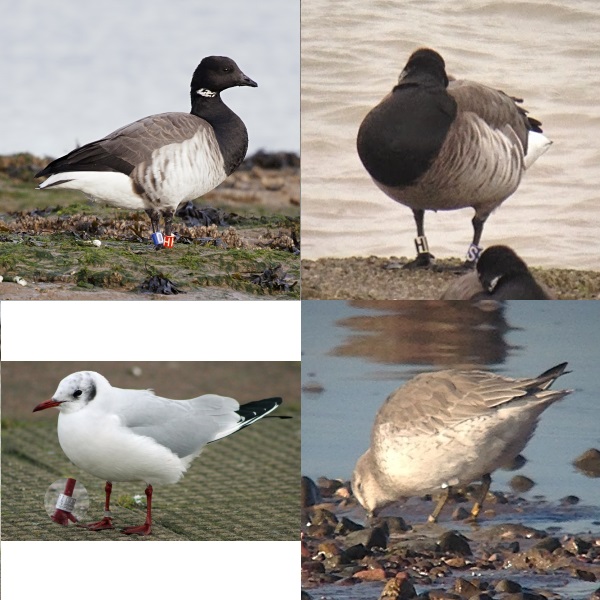
Colour-ringed Brent Geese have been recorded by the Hilbre
Bird
Observatory for a number of years. Up to now these have all
been of the light-bellied race which breed in Canada with most
spending the winter in Ireland. There is another population of
light-bellied brents which breeds in Svalbard and spend the winter in
Denmark and Lindisfarne, Northumberland (known as the East Atlantic
population). Interestingly, this is the smallest discrete population of
migrating geese in the world with an estimate of just 7,600 individuals
in 2009.
For the first time one of these Svalbard birds was identified at Hilbre
this winter - see details below with two other Brents (see photos).
Brent Geese
YTGR
(Y on green ring, T on red ring) - ringed at Limfjord Staging area,
Denmark, on May 3rd 2011.
Recorded on Hilbre on December 16th 2014 and January 14th 2015 (and
various other dates this winter).
Previous record: Lindisfarne in north east England on 26th March 2013
HDRB
(H on red ring, D on blue ring - see photo) - ringed on
Axel Heiburg Island (Arctic Canada) on August 2nd 2007.
Recorded on Hilbre in November, December 2014 and January 2015.
First recorded on Hilbre on December 24th 2008 and recorded every
winter since.
HSWB
(H on white ring, S on blue ring - see photo) - ringed in Dungarvan
Harbour
(Northern Ireland) on December 18th December 2008.
Recorded on Hilbre in November, December 2014 and January 2015.
First recorded on Hilbre on November 12th 2010 and recorded
every winter since.
Thanks to the Irish Brent Goose
Research Group (www.irishbrentgoose.org)
for information about these birds.
Knot
Unfortunately, the Knot in the
photograph above has a ring missing so we can't identify it
individually, but the white flag on the left tibia identifies it as a
Canadian ringed bird and the two yellow rings on the right tarsus means
it was ringed sometime between July 9th 2001 and June 16th 2007
at Alert, Ellesmere Island, Nunavut, Canada - just 500 miles
from the North Pole!
This bird was recorded at Thurstaston on February 6th 2015.
Black-headed Gull
Metal
Ring EK57175 - Ringed by Alan Hitchmough in New Brighton
on December 30 th
2009.
Recorded in New Brighton on January 17th 2015.
Previous record: Talacre Beach (Point of Ayr) on August 17th 2014.
Not a very exciting record but it does demonstrate how site faithful
Black-headed Gulls are and also that, with today's cameras and
telescopic lenses, it is not only colour rings that can be read without
re-catching the bird.
Colour-ringed birds were also recorded by Hilbre Bird Observatory, Elliot Monteith, Steve Hinde, John Jakeman and Alan Irving. Top of Page
Hilbre Video
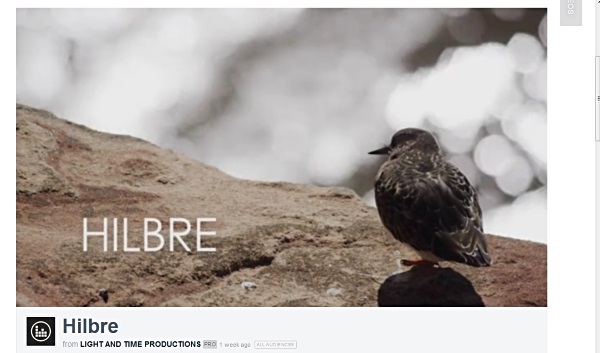
Top of Page
March Bird News
 Scoters were very much in evidence
with
numbers of Common Scoters approaching those of last year with at least
20,000 counted on the 28th. But it was a Surf Scoter which caused great
excitement, it was thought one was present in the vast flocks but it
was just too distant from Hoylake prom to reliably identify so a trek
out to the edge of
East Hoyle Bank was undertaken and it was a rewarding trip! It was
discovered on the 25th, and to quote the Lighthouse
Blog "Cheshire and Wirral's long awaited first Surf Scoter
was discovered early this morning among the many
thousands of Common Scoter off Hoylake by lighthouse regulars Allan
Conlin and Kenny Dummigan, a well deserved reward for many weeks of
searching for this species here." Also recorded were up to six Velvet
Scoters, three Eider and two Long-tailed Ducks. Two Eiders were off
Heswall and Parkgate during the spring tides.
Scoters were very much in evidence
with
numbers of Common Scoters approaching those of last year with at least
20,000 counted on the 28th. But it was a Surf Scoter which caused great
excitement, it was thought one was present in the vast flocks but it
was just too distant from Hoylake prom to reliably identify so a trek
out to the edge of
East Hoyle Bank was undertaken and it was a rewarding trip! It was
discovered on the 25th, and to quote the Lighthouse
Blog "Cheshire and Wirral's long awaited first Surf Scoter
was discovered early this morning among the many
thousands of Common Scoter off Hoylake by lighthouse regulars Allan
Conlin and Kenny Dummigan, a well deserved reward for many weeks of
searching for this species here." Also recorded were up to six Velvet
Scoters, three Eider and two Long-tailed Ducks. Two Eiders were off
Heswall and Parkgate during the spring tides.
Right above: record shots of the Surf
Scoter
by Steve Williams, also see Steve's YouTube videos https://www.youtube.com/watch?v=-AaPL5TfPzc&feature=youtu.be
and
https://www.youtube.com/watch?v=iHrFovlH7DM&feature=youtu.be.
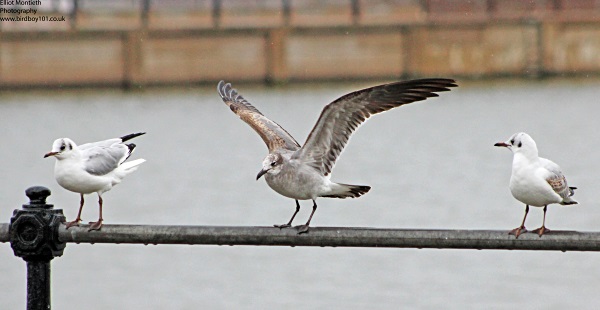
The Laughing Gull is still at New
Brighton (see March
Newsletter),
a Glaucous Gull was at both Hoylake and Wallasey early in the month, a
Caspian Gull was at Meols on the 28th and an Iceland Gull was seen on
several occasions along north Wirral.

Avocet numbers built up to at least 40 at Burton Mere Wetlands, some of these will be on their way further north but hopefully quite a few will stay to breed. Also at BMW was the long-staying Long-eared Owl, two Great White Egrets and a couple of Cetti's Warblers. Numbers of Cetti's Warblers breeding around the Dee estuary must surely be now in double-figures - strictly speaking it is still a county rarity!

The spring migration was slow in March, as it often is, but first dates of most migrants were typical for recent years. The first Sand Martin was early but we have had earlier dates. Although a passage of Stonechats probably occurs most years it usually involves just one or two birds but this year we have had a really good number of birds with the total of daily records coming to 61 - which includes a max of five at Parkgate, at least 10 on the Hoylake Langfields and 15 in the Leasowe Lighthouse/Leasowe Castle area.
| Species | 2015 | Location (2015) | 2014 | 2013 |
|---|---|---|---|---|
| Sand Martin | 7th March | Flint | 20th March | 28th March |
| White Wagtail | 10th March | Red Rocks | 8th March | 14th March |
| Wheatear | 11th March | Hilbre | 10th March | 17th March |
| Swallow | 20th March | Burton | 19th March | 10th April |
| Willow Warbler | 22nd March | Flint | 12th March | 6th April |
| House Martin | 31st March | Burton | 29th March | 12th April |
| Whitethroat | 4th April | 15t April | ||
| Cuckoo | 2nd May | 13th April | ||
| Swift | 3rd May | 17th April |
Richard Smith.
What to expect in April
In the estuary Whimbrels will be heading north on their way from West Africa to Iceland and northern Scandinavia. The last two years has seen a build up of over 1,000 Black-tailed Godwits in West Kirby - either at Gilroy or the Caldy Wildfowl Collection - pausing on their way to Iceland and looking glorious in full breeding plumage. Over the marshes we should see Marsh Harriers and we usually have several Ospreys with hopefully one or two pausing for a few hours for a spot of fishing.
But perhaps it's the land birds which most birders look forward to, both the return of our breeding birds and those on passage which are only seen at this time of year. Last April was particularly good for Redstarts but each year is different. Species to look out for in particular are Ring Ouzels, Yellow Wagtails, White Wagtails, Whinchats, Grasshopper Warblers and both Common and Lesser Whitethroats. Some mornings we can go out and every bush seems to have a singing warbler, every fence post a Whinchat and every field covered in Wheatears and wagtails.
April is a great month for rarities and last year alone we had Little Bunting, Night Heron, Velvet Scoter and Wryneck.
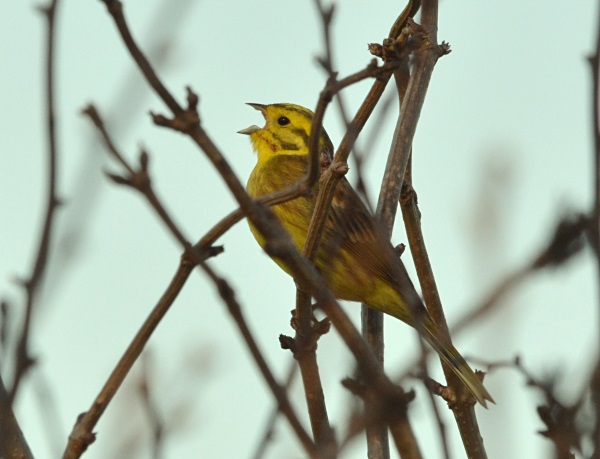
Top of Page
Forthcoming Events
April Highest Spring Tides (Liverpool)
Also
see Tides
page.
18th April, 11.30hrs (BST), 9.8m.
19th April, 12.16hrs (BST), 10.0m.
20th April, 13.00hrs (BST), 10.0m.
21st April, 13.44hrs (BST), 9.7m.
Forthcoming Events
Organised by the Wirral
Ranger Service , Flintshire
Countryside Service and the
RSPB (Dee Estuary):
All these events and walks have bird interest, even those not
advertised specifically for birdwatching. No need to book for these
events unless specified - please check below.
Also see 2015 Events Diary.
Saturday 18th April and Sunday 3rd May (also two later dates in May), Weekend Walkabout at Burton Mere Wetlands.
1 pm-3 pm (approx. finish)
Price: Free (normal reserve entry charges apply to non-members)
Join one of our friendly, knowledgeable volunteers for a gentle walk from the Reception Hide to the end of the Hillfort Trail on Burton Point, to learn more about the wildlife that thrives here, the work we do to give nature a home and the remarkable history of the estuary.
Great for first time visitors or those who'd like a guide to help them get the most enjoyment from a visit. With constant changes as we move through the seasons, it's impossible to predict what might be seen but nesting wading birds, herons and ducks are guaranteed, with an array of colourful flowers, butterflies and dragonflies emerging into the warmer months, there's always something to marvel.
No booking required, just turn up on the day. A reasonable level of fitness and sturdy footwear are required.
Telephone 0151 353 8478 for further details.
Saturday 25th April, 10 am-4 pm, Binocular and Telescope Demo Day at Burton Mere Wetlands.
Price: Free
Are you interested in a new pair of binoculars, or want to try a telescope, but not sure what to look for or what the numbers mean?
If so, don't miss this event, with helpful staff from RSPB Conwy here to give you expert advice on choosing the best binoculars, telescopes and accessories to suit your needs. There will be a wide range of choice, and stock available to buy and take away on the day. Card payment facilities will be available.
The event will be held outside the Reception Hide, giving you a great opportunity to try products. It's free, but normal admission charges do apply for non-member visitors wanting to head around the reserve too. Whether you're choosing your first binoculars or looking to upgrade, we'll have the right optics for you.
Telephone 0151 353 8478 for further details.
Sunday May 3rd - 4:30am - 6:30am, Dawn Chorus at Royden Park.
Listen to the fantastic sounds of nature as birds sing at this very early time of year.
If you have them, bring a pair of binoculars.
Meet at the Court Yard/Coach House at Royden Park.
Sorry no dogs.
Booking essential.
Telephone:
0151 677 7594.